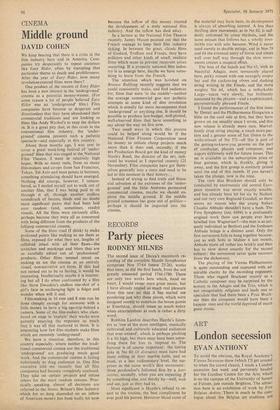RECORDS
Party pieces
RODNEY MILNES
The second issue of Decca's mammoth re.4 cording of the complete Haydn Symphonies comprises Nos 57-64 (HDNE 23.26), works that stem, as did the first batch, from the not greatly esteemed period 1766-1780. There are only two works here which, hand on heart, I would swear were great music, but I have already reaped so much real pleasure from this new set that it has started me pondering just why these pieces, which were designed merely to entertain the house guests at Esterhaza, should mean so much today when entertainment as such is rather a dirty word.
Robbins Landon describes Haydn's listen ers as 'one of the most intelligent, musically cultivated and culturally educated audiences that ever existed', which is perhaps pitching it a bit high, but there must have been some- thing there for him to respond to. The humour is of course important: the tuning joke in No 60 (Il distratto) must have had them rolling in their marble halls, and so must, at a. less rudimentary level, the sur- prises in the same work's first movement: three perdendosi's followed first by a fort4 issitno, secondly, when you are expecting fl by something else, and thirdly by—well, wait and see, just as they had to.
Most significant is Haydn's refusal to re- sort to the routine, the best compliment he ever paid his patron. However bland some of the material may have been, its development is always of absorbing interest. A less than thrilling slow movement, as in No 62, is sud- denly enlivened by cross rhythms, and the tame minuet that follows has a wholly irres- istible trio with solo bassoon. Wind is never used merely to double strings, and in Nos 59 and 64 the eventual entry of horns and oboes well over half way through the slow move- ments creates a magical effect.
The best of the bunch are No 61, with its beautiful Adagio, most sensuously played here, perky minuet with one strangely empty bar and the cuckoo-ing oboes and dashing string writing in the Finale, and the more weighty No 64, which has a retharkable Largo—taken very slowly, but brilliantly sustained by the players—and a sophisticated, asymmetrically phrased Finale.
I found the performances of the first issue by Dorati and the Philharmonia Hungarica a little on the cool side at first, but they have grown on me steadily since I wrote, and this new release is already more sure. Marvel- lously crisp string playing, a touch more pas- sion and a greater sense of fun (listen to the waltz-minuet of No 57)—all this is part of the getting-to-know-you process on the part of conductor, players and composer, and augurs extremely well for future issues. This set is available at the subscription price of four guineas, which is, frankly, giving it away, and the first group is similarly priced until the end of this month. If you haven't taken the plunge, now is the time.
The view that 'Bruckner should only be conducted' by enormously old central Euro- pean maestros was never exactly tenable, and has already been hit for six by Haitink and our very own Reginald Goodall, so there seems no reason why the young Italian Claudio Abbado shouldn't have a bash. The First Symphony (sxt, 6494) is a profoundly original work (how can people ever have labelled him Wagnerian?—the man is as uni- quely individual as Berlioz) and the freshness Abbado brings is a distinct asset. Only the first movement fails to hang together because, just as with Solti in Mahler 6 last month, Abbado starts off rather too briskly and then has to slow down smartly for the second subject : the movement never quite recovers from the dichotomy.
The playing of the Vienna Philharmonic is quite outstanding and captured with ad- mirable clarity by the recording engineers. Those who regard Bruckner mainly as a Catholic composer may be surprised by the ecstasy in the Adagio and the Trio, which is not recognisably religious and leads one to speculate that had there been a Frau Bruck- ner then the composer would have been a happier man and the world deprived of much great music.










































 Previous page
Previous page